MercoPress. South Atlantic News Agency
Tag: blue dollar
-
Wednesday, October 22nd 2025 - 10:08 UTC
Argentina: Dollar soars despite Central Bank and US Treasury interventions
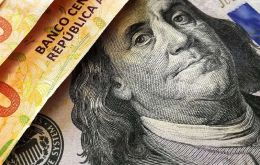
The Argentine financial market saw significant intervention by both the Argentine Central Bank (BCRA) and the US Treasury on Tuesday to prevent the wholesale dollar from piercing the ceiling of its official exchange band of AR$1,491. The BCRA sold US$45.5 million in reserves to cap the price.
-
Monday, July 15th 2024 - 10:33 UTC
Argentine President warns of hard times ahead
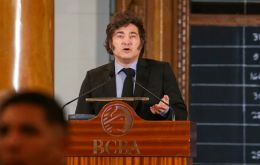
Argentine President Javier Milei downplayed this weekend from Sun Valley, Idaho, the importance of the “blue” (a euphemism for “black market”) dollar going up in his country. However, he warned of “difficult” weeks to come as his Government starts a new zero-money-issuing phase, which he dubbed “a new upgrade of the monetary policy.”
-
Saturday, July 13th 2024 - 08:02 UTC
Indec says Argentina's CPI in June reached 4.6%
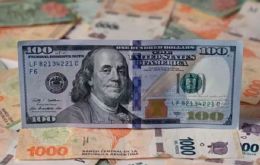
The Consumer Price Index (CPI) reached 4.6% last month in Argentina for a year-on-year 271.5%, according to a National Institute of Statistics and Census (Indec) survey released Friday. These figures also yielded a 79.8% increase in the first semester of 2024.
-
Monday, April 8th 2024 - 10:22 UTC
Milei reverses shopping trends in less than 4 months in office
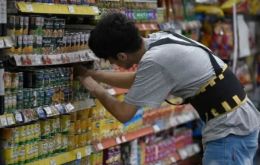
Argentine President Javier Milei has been in office for less than 4 months, more than enough time to turn things around for people in neighboring countries. Uruguayans who used to do their shopping across the border no longer find it profitable, while Argentines flocked to Chile over the Easter weekend to do theirs.
-
Thursday, January 18th 2024 - 21:13 UTC
Argentina: Record highs in parallel dollar rates as the country grapples with economic challenges
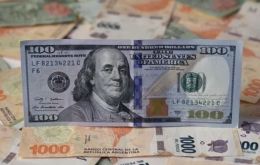
The strength of the dollar in alternative markets is once again exerting pressure on financial dealings on Thursday, with the exchange rate gap reaching 60%, posing challenges to President Javier Milei's economic plan amidst soaring inflation and increasing poverty.
-
Wednesday, November 22nd 2023 - 10:10 UTC
Argentina:“Blue” dollar bounces back nearing historic highs

The “blue” (a euphemism for “black market”) dollar rose AR$ 125 Tuesday on the first working day after Sunday's presidential runoff and once again pierced the psychological AR$ 1,000 barrier upwards, closing at AR$ 1.025 / 1.075 (buy/sell), thus getting closer to its historical AR$ 1,100 high for a gap of 202% with the official quotation.
-
Friday, October 27th 2023 - 10:25 UTC
Sharp drop on “blue” dollar reported in Argentina

The “blue” (a euphemism for “black market”) dollar has fallen sharply against the Argentine peso this week after Sunday's elections and the subsequent fracture within the opposition JxC coalition regarding whether to support or not Libertarian Congressman Javier Milei's bid against Economy Minister Sergio Massa at the Nov. 19 runoff.
-
Wednesday, October 25th 2023 - 10:51 UTC
“The Croatian,” alleged mastermind behind the “blue” dollar, arrested in Buenos Aires

Argentine authorities Tuesday arrested Ivo Rojnica, a.k.a. “The Croatian,” who is believed to be the mastermind behind the US dollar black market, commonly referred to as “blue,” it was reported in Buenos Aires.
-
Tuesday, October 24th 2023 - 09:39 UTC
“Blue” dollar back on surging track day after Argentine elections
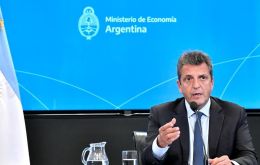
The “blue” (a euphemism for “black market”) dollar stood at AR$ 1,100 Monday, an AR$ 200 increase from Friday's quotation, after Sunday's elections which saw Economy Minister Sergio Massa and Libertarian Congressman Javier Milei advance to the Nov. 19 runoff, it was reported in Buenos Aires.
-
Thursday, October 19th 2023 - 10:41 UTC
Blue dollar plummets in Argentina
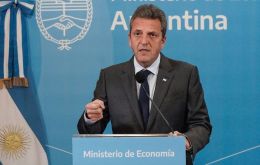
The “blue” (a euphemism for “black market”) dollar plunged on Wednesday, closing at AR$ 885/905 (buy/sell), down from AR$ 985 the previous day, after the extension of the swap with China was announced and raids on illegal exchange parlors known as “cuevas” (caves) intensified, leading to new arrests, it was reported in Buenos Aires.
